A Compact, Low-Profile, Broadband Quasi-Isotropic Antenna for Non-Line-of-Sight Communications
Abstract
:1. Introduction
2. Broadband Quasi-Isotropic Antenna Design
2.1. Crossed Dipole Antenna
2.2. Development of a Fork-Shaped Crossed Dipole Antenna
2.3. Parameter Studies
2.4. Final Design of the Proposed Antenna
3. Antenna Radiation Properties
3.1. Radiation Pattern
3.2. CP Performance
4. Measurements with the Built Prototype
5. Antenna Performance Verification under an NLOS Environment
6. Conclusions
Author Contributions
Funding
Institutional Review Board Statement
Informed Consent Statement
Data Availability Statement
Conflicts of Interest
References
- Park, P.; Ergen, S.C.; Fischione, C.; Lu, C.; Johansson, K.H. Wireless network design for control systems: A survey. IEEE Commun. Surv. Tuts. 2018, 20, 978–1013. [Google Scholar] [CrossRef]
- Radha, S.M.; Jung, M.; Park, P.; Yoon, I.-J. Design of an electrically small, planar quasi-isotropic antenna for enhancement of wireless link reliability under NLOS channels. Appl. Sci. 2020, 10, 6204. [Google Scholar] [CrossRef]
- Luvisotto, M.; Pang, Z.; Dzung, D. High-performance wireless networks for industrial control applications: New targets and feasibility. Proc. IEEE 2019, 107, 1074–1093. [Google Scholar] [CrossRef]
- Lin, W.; Ziolkowski, R.W. Wirelessly powered light and temperature sensors facilitated by electrically small omni-directional and Huygens dipole antennas. Sensors 2019, 19, 1998. [Google Scholar] [CrossRef]
- Ta, S.X.; Choo, H.; Park, I.; Ziolkowski, R.W. Multi-band, wide-beam, circularly polarized, cross, asymmetrically barbed dipole antennas for GPS applications. IEEE Trans. Antennas Propag. 2013, 61, 5771–5775. [Google Scholar] [CrossRef]
- Park, P. Markov chain model of fault-tolerant wireless networked control systems. Wirel. Netw. 2018, 25, 2291–2303. [Google Scholar] [CrossRef]
- Baik, J.W.; Lee, T.H.; Pyo, S.; Han, S.M.; Jeong, J.; Kim, Y.S. Broadband circularly crossed dipole with parasitic loop resonators and its array. IEEE Trans. Antennas Propag. 2011, 59, 80–88. [Google Scholar] [CrossRef]
- Youn, S.; Jang, B.; Choo, H. Design of a UWB antenna with multiple ports on a single circular radiator for directing-finding applications. J. Electromagn. Eng. Sci. 2023, 23, 63–68. [Google Scholar] [CrossRef]
- Wang, X.; Zhao, Z.; Chen, G.; He, F. RF energy harvesting with broadband antenna. In Proceedings of the 2014 IEEE Conference and Expo Transportation Electrification Asia-Pacific (ITEC Asia-Pacific), Beijing, China, 31 August–3 September 2014; pp. 1–5. [Google Scholar]
- Maher, R.; Tammam, E.; Galal, I.; Hamed, H.F. Design of a broadband planar antenna for RF energy harvesting. In Proceedings of the International Conference on Electrical, Electronics, and Optimization Techniques (ICEEOT), Chennai, India, 3–5 March 2016; pp. 1808–1810. [Google Scholar]
- Hagerty, J.A.; Helmbrecht, F.B.; McCalpin, W.H.; Zane, R.; Popovic, Z.B. Recycling ambient microwave energy with broad-band rectenna arrays. IEEE Trans. Microw. Theory Tech. 2004, 52, 1014–1024. [Google Scholar] [CrossRef]
- Long, H.; Liu, Y.; Wang, Y.; Dick, R.P.; Yang, H. Battery allocation for wireless sensor network lifetime maximization under cost constraints. In Proceedings of the IEEE/ACM International Conference on Computer-Aided Design-Digest of Technical Papers, San Jose, CA, USA, 2–5 November 2009; pp. 705–712. [Google Scholar]
- Mathis, H.F. A short proof that an isotropic antenna is impossible. Proc. IRE 1951, 8, 970. [Google Scholar]
- Brouwer, L.E.J. On Continuous Vector Distributions on Surfaces; Proc. KNAW: Amsterdam, The Netherlands, 1909; Volume 11, pp. 850–858. [Google Scholar]
- Bugnolo, D. A quasi-isotropic antenna in the microwave spectrum. IRE Trans. Antennas Propag. 1962, 10, 377–383. [Google Scholar] [CrossRef]
- Radha, S.M.; Shin, G.; Park, P.; Yoon, I.-J. Realization of electrically small, low-profile quasi-isotropic antenna using 3D printing technology. IEEE Access 2020, 8, 27067–27073. [Google Scholar] [CrossRef]
- Bou-El-Harmel, A.; Benbassou, A.; Belkadid, J.; Mechatte, N. Effect of quasi-isotropic antenna orientation on indoor multipath propagation characteristics in RSN applications. Int. J. Antennas Propag. 2017, 2017, 2686123. [Google Scholar] [CrossRef]
- Pan, G.; Li, Y.; Zhang, Z.; Feng, Z. Isotropic radiation from a compact planar antenna using two crossed dipoles. IEEE Antennas Wirel. Propag. Lett. 2012, 11, 1338–1341. [Google Scholar]
- Kim, J.; Park, J.; Omar, A.A.; Hong, W. A symmetrically stacked planar antenna concept exhibiting quasi-isotropic radiation coverage. IEEE Antennas Wirel. Propag. Lett. 2020, 19, 1390–1394. [Google Scholar] [CrossRef]
- Kim, J.-H.; Nam, S. Design of a compact dual band quasi-isotropic antenna. Electron. Lett. 2017, 53, 515–516. [Google Scholar] [CrossRef]
- Su, Z.; Klionovski, K.; Bilal, R.M.; Shamim, A. A dual band additively manufactured 3-D antenna on package with near-isotropic radiation pattern. IEEE Trans. Antennas Propag. 2018, 66, 3295–3305. [Google Scholar] [CrossRef]
- Radha, S.M.; Shin, G.; Kim, W.; Shah, S.I.H.; Yoon, I.-J. Design and verification of an electrically small, extremely thin dual-band quasi-isotropic antenna. IEEE Antennas Wirel. Propag. Lett. 2020, 19, 2482–2486. [Google Scholar] [CrossRef]
- Tang, Z.-J.; He, Y.-G.; Wang, Y. Broadband UHF RFID tag antenna with quasi-isotropic radiation performance. Int. J. Electron. Commun. 2011, 65, 859–863. [Google Scholar] [CrossRef]
- Cho, C.; Choo, H.; Park, I. Broadband RFID tag antenna with quasi-isotropic radiation pattern. Electron. Lett. 2005, 41, 1091–1092. [Google Scholar] [CrossRef]
- Deng, C.; Li, Y.; Zhang, Z.; Feng, Z. A wideband isotropic radiated planar antenna using sequential rotated L-shaped mon-opoles. IEEE Trans. Antennas Propag. 2014, 62, 1461–1464. [Google Scholar] [CrossRef]
- Su, Z.; Klionovski, K.; Liao, H.; Chen, Y.; Elsherbeni, A.Z.; Shamim, A. Antenna-on-package design: Achieving near-isotropic radiation pattern and wide CP coverage simultaneously. IEEE Trans. Antennas Propag. 2021, 69, 3740–3749. [Google Scholar] [CrossRef]
- Pazin, L.; Dyskin, A.; Leviatan, Y. Quasi-isotropic X-band inverted-F antenna for active RFID tags. IEEE Antennas Wirel. Propag. Lett. 2009, 8, 27–29. [Google Scholar] [CrossRef]
- Shah, S.I.H.; Radha, S.M.; Park, P.; Yoon, I.-J. Recent advancements in quasi-isotropic antennas: A review. IEEE Access 2021, 9, 146296–146317. [Google Scholar] [CrossRef]
- Su, Z.; Klionovski, K.; Liao, H.; Li, W.; Shamim, A. A fully-printed 3D antenna with 92% quasi-isotropic and 85% CP coverage. IEEE Trans. Antennas Propag. 2022, 70, 7914–7922. [Google Scholar] [CrossRef]
- Huchard, M.; Delaveaud, C.; Tedjini, S. Miniature antenna for circularly polarized quasi isotropic coverage. In Proceedings of the 2nd European Conference on Antennas and Propagation (EuCAP 2007), Edinburgh, UK, 11–16 November 2007; pp. 1–5. [Google Scholar]
- Wu, D.L. Omnidirectional circularly-polarized conformal microstrip array for telemetry applications. IEEE Antennas Propag. Soc. Int. Symp. 1995, 2, 998–1001. [Google Scholar]
- Hall, R.C.; Wu, D.I. Modeling and design of circularly-polarized cylindrical wraparound microstrip antennas. In Proceedings of the International Symposium Antennas Propagation, Baltimore, MD, USA, 21–26 July 1996; pp. 672–675. [Google Scholar]
- Ta, S.X.; Park, I.; Ziolkowski, R.W. Crossed dipole antennas: A review. IEEE Antennas Propag. Mag. 2015, 57, 107–122. [Google Scholar] [CrossRef]
- Radha, S.M.; Lee, M.-S.; Yoon, I.-J. A Compact broadband quasi-isotropic antenna for wireless energy harvesting applications. In Proceedings of the 2022 International Symposium on Antennas and Propagation (ISAP), Sydney, Australia, 31 October–3 November 2022; pp. 137–138. [Google Scholar]
- Ta, S.X.; Park, I. Compact wideband sequential-phase feed for sequentially rotated antenna arrays. IEEE Antennas Wirel. Propag. Lett. 2017, 16, 661–664. [Google Scholar] [CrossRef]
- Bolster, M.F. A new type of circular polarizer using crossed dipoles. IRE Trans. Microw. Theory Tech. 1961, 9, 385–388. [Google Scholar] [CrossRef]
- Ta, S.X.; Park, I.; Ziolkowski, R.W. Broadband electrically small circularly polarized directive antenna. IEEE Access 2017, 5, 14657–14663. [Google Scholar] [CrossRef]
- Shin, H.W.; Kim, H.D. Enhancing efficiency for wideband antennas by controlling the parasitic resonance of the feed structure. J. Electromagn. Eng. Sci. 2021, 22, 399–402. [Google Scholar] [CrossRef]
- Huynh, M.-C. Wideband Compact Antenna for Wireless Communications Applications. Ph.D. Dissertation, Virginia Polytechnic Institute and State University, Blacksburg, VA, USA, 2004. [Google Scholar]
- Farooqui, M.F.; Claudel, C.; Shamim, A. An inkjet-printed buoyant 3-D lagrangian sensor for real-time flood monitoring. IEEE Trans. Antennas Propag. 2014, 62, 3354–3359. [Google Scholar] [CrossRef]
- Ferrite Beads: 2661000301. Available online: https://www.fair-rite.com/product/emi-suppression-beads-2661000301/ (accessed on 5 January 2024).
- Arrawatia, M.; Baghini, M.S.; Kumar, G. Broadband modified elliptical ring quasi-isotropic antenna. In Proceedings of the IEEE International Symposium on Antennas and Propagation & USNC/URSI, Boston, MA, USA, 8–13 July 2018; pp. 1055–1056. [Google Scholar]
- Ultra Wide Band Omni Directional Antenna. Available online: http://antenna-pro.com/product/detail.html?product_no=2073&cate_no=166&display_group=1 (accessed on 5 January 2024).
- High Power Amplifier: ZHL-2W-63x-S+. Available online: https://www.minicircuits.com/WebStore/dashboard.html?model=ZHL-2W-63X-S%2B (accessed on 5 January 2024).
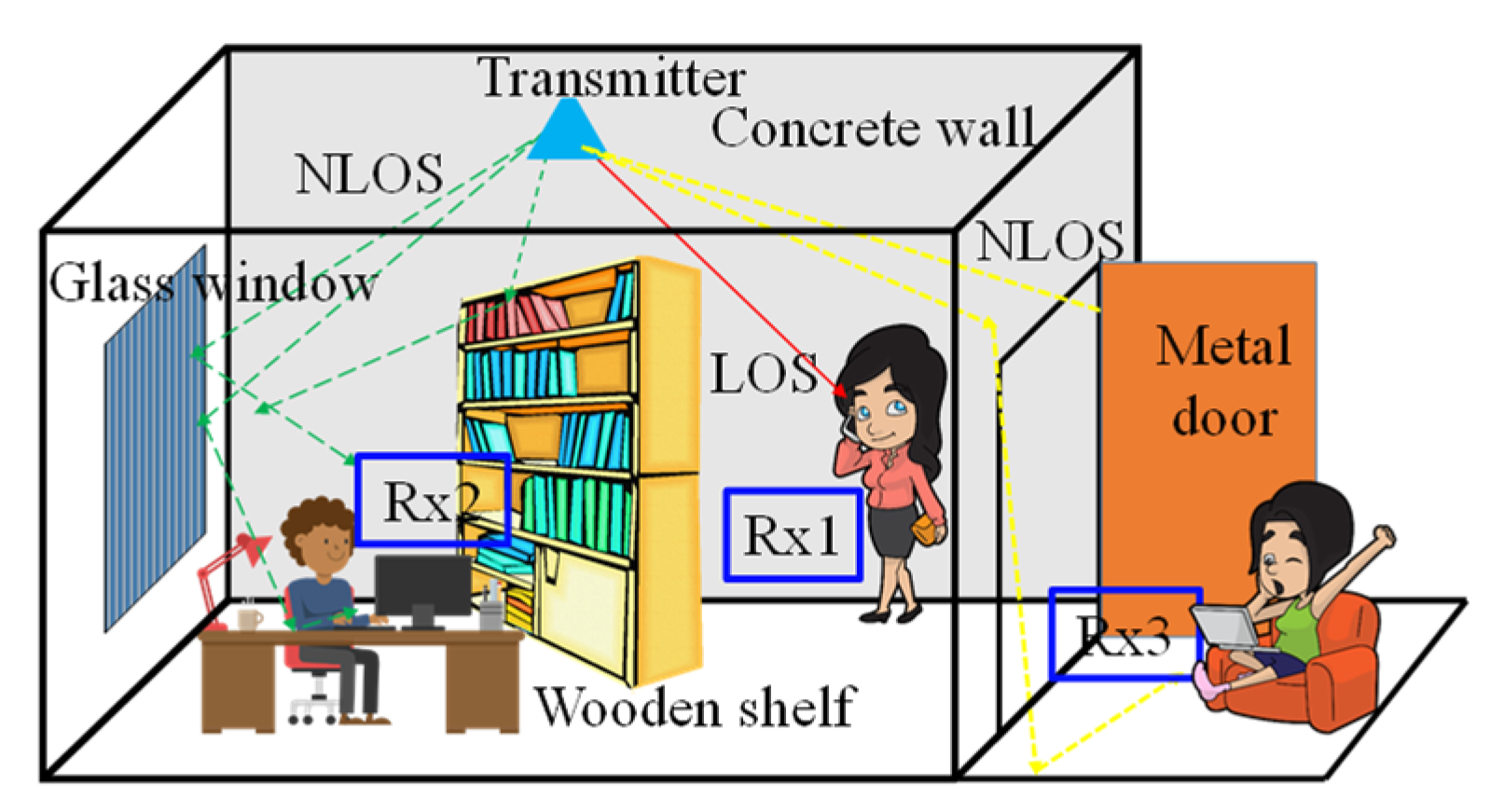

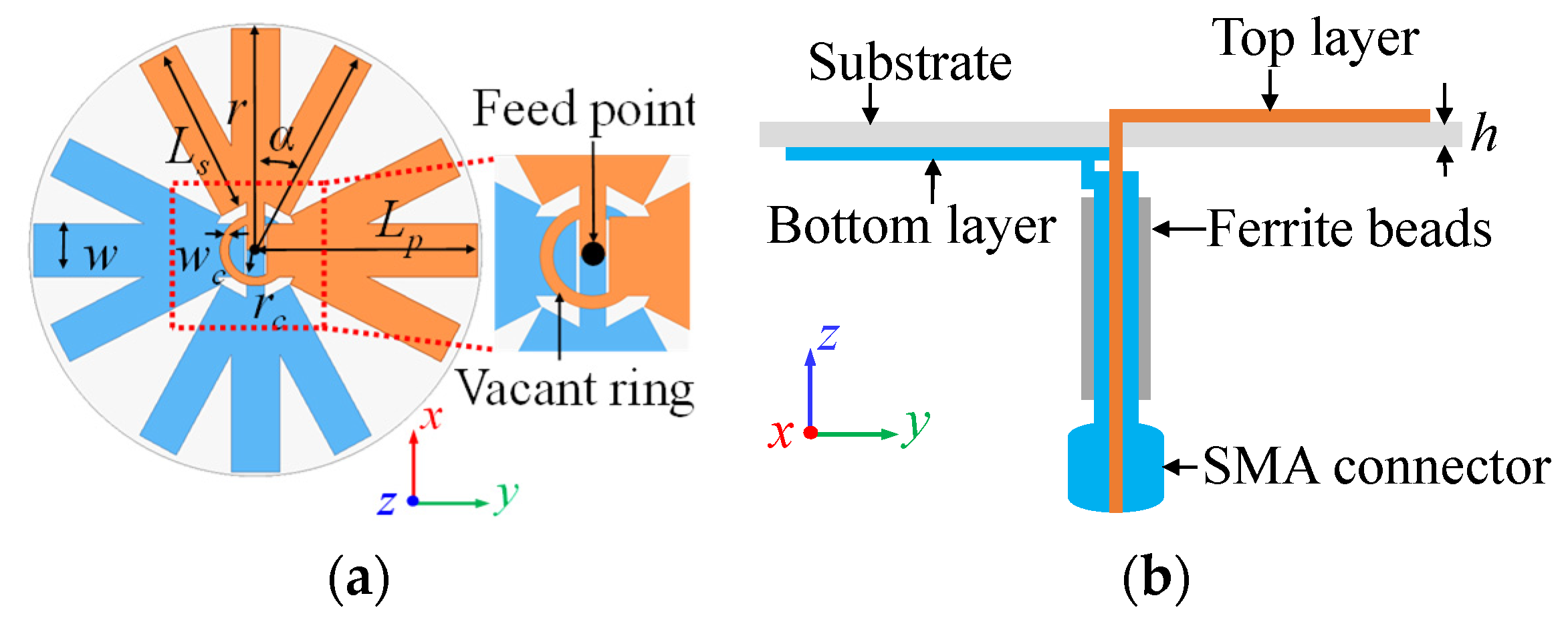

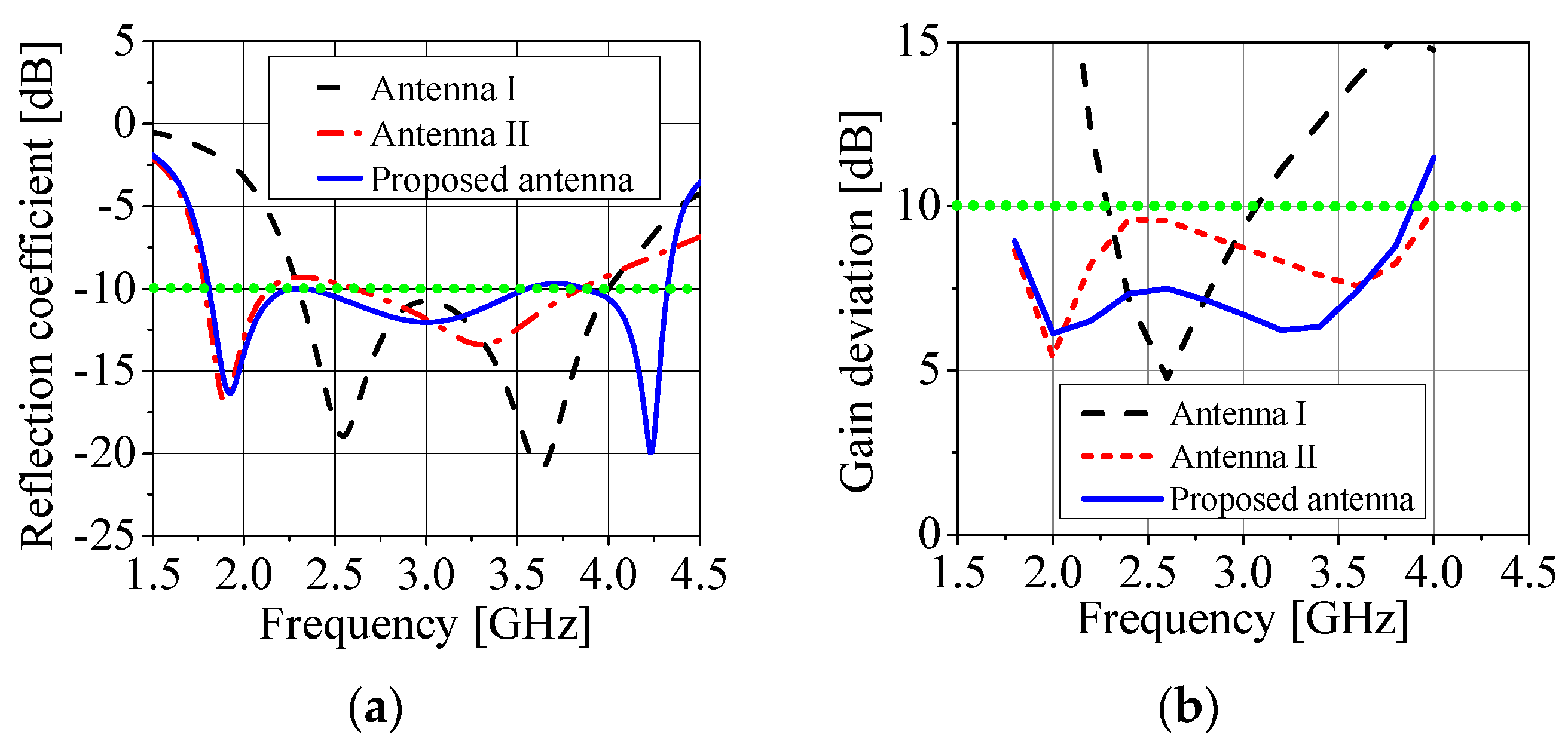

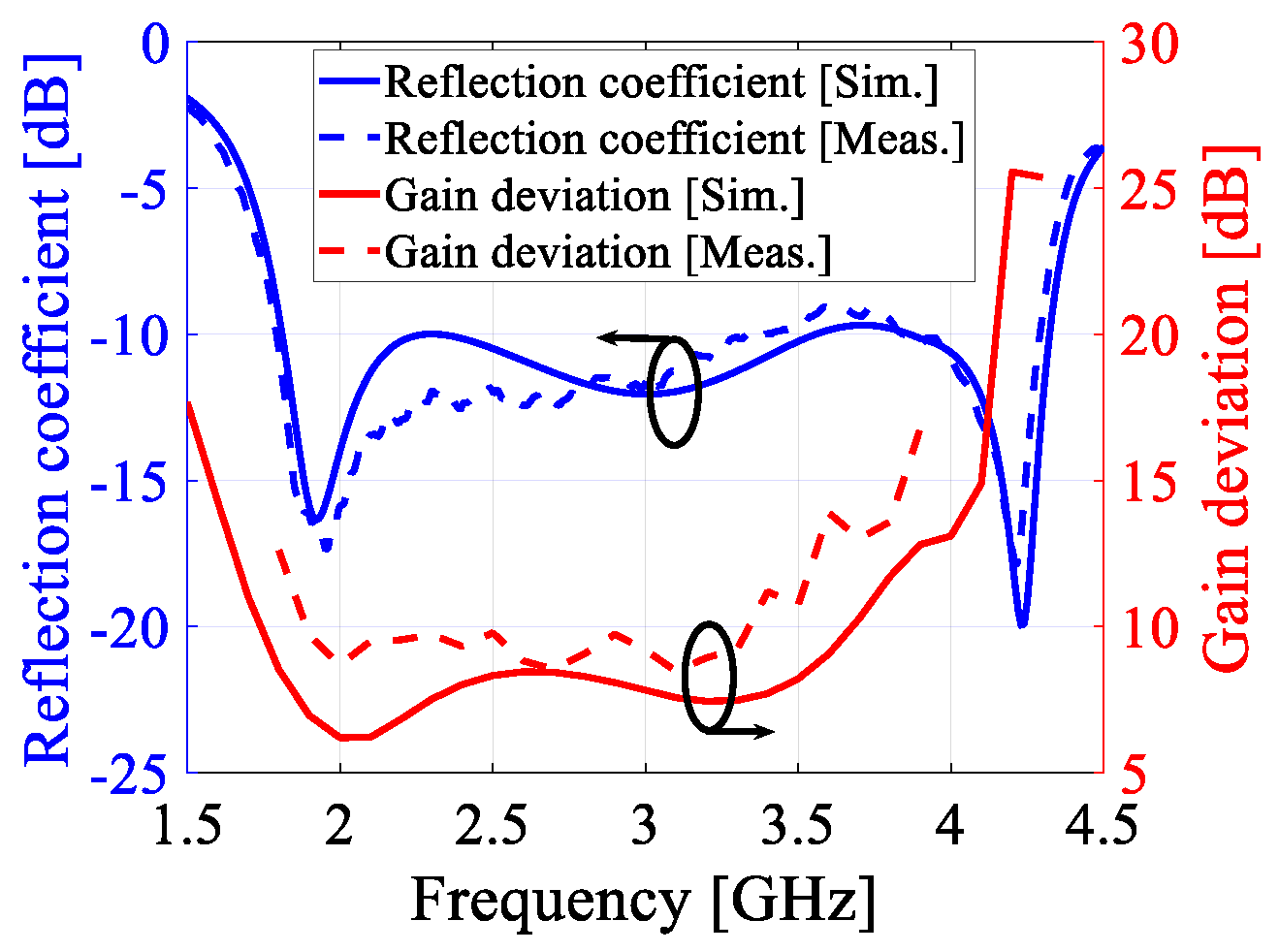
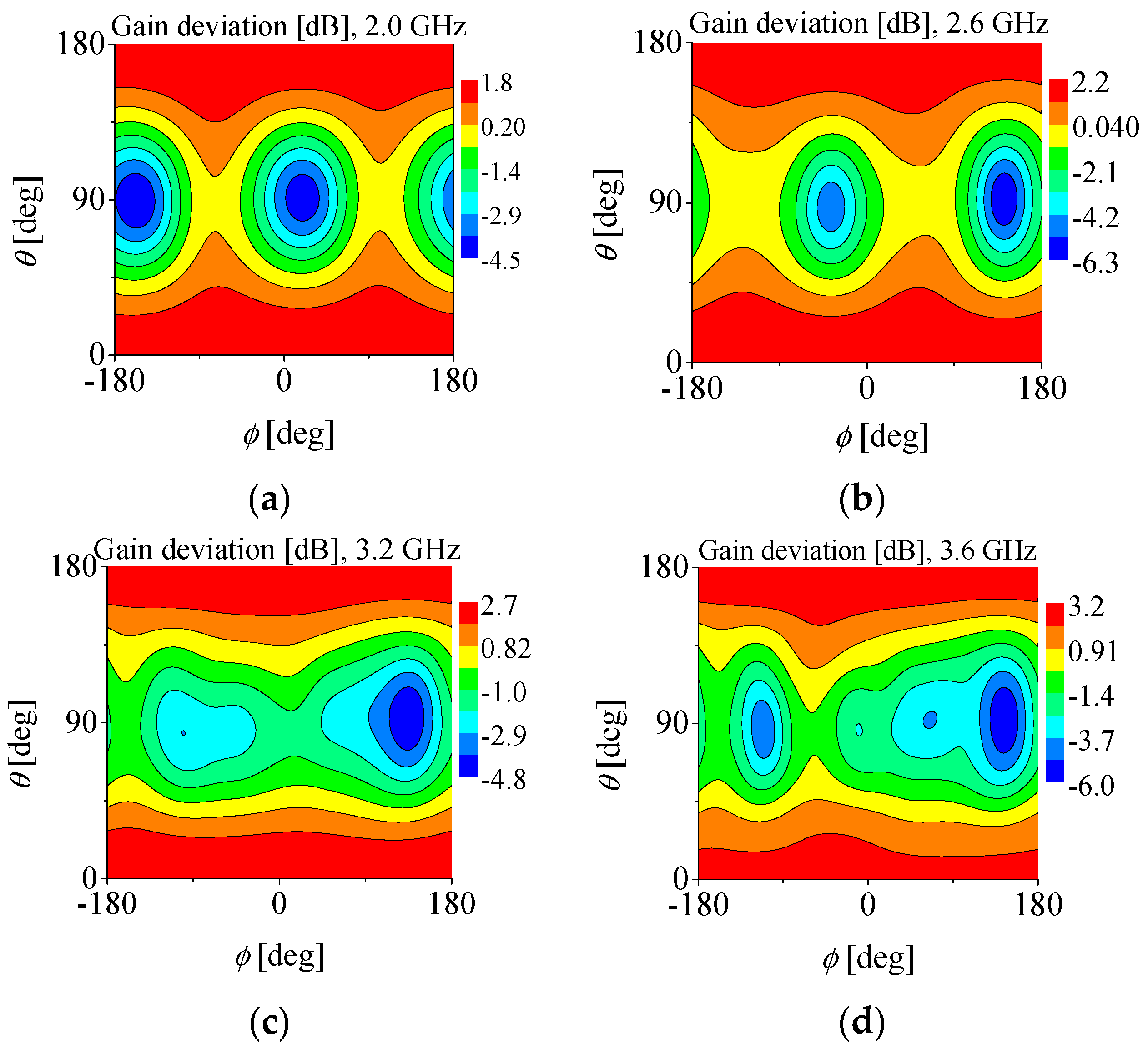

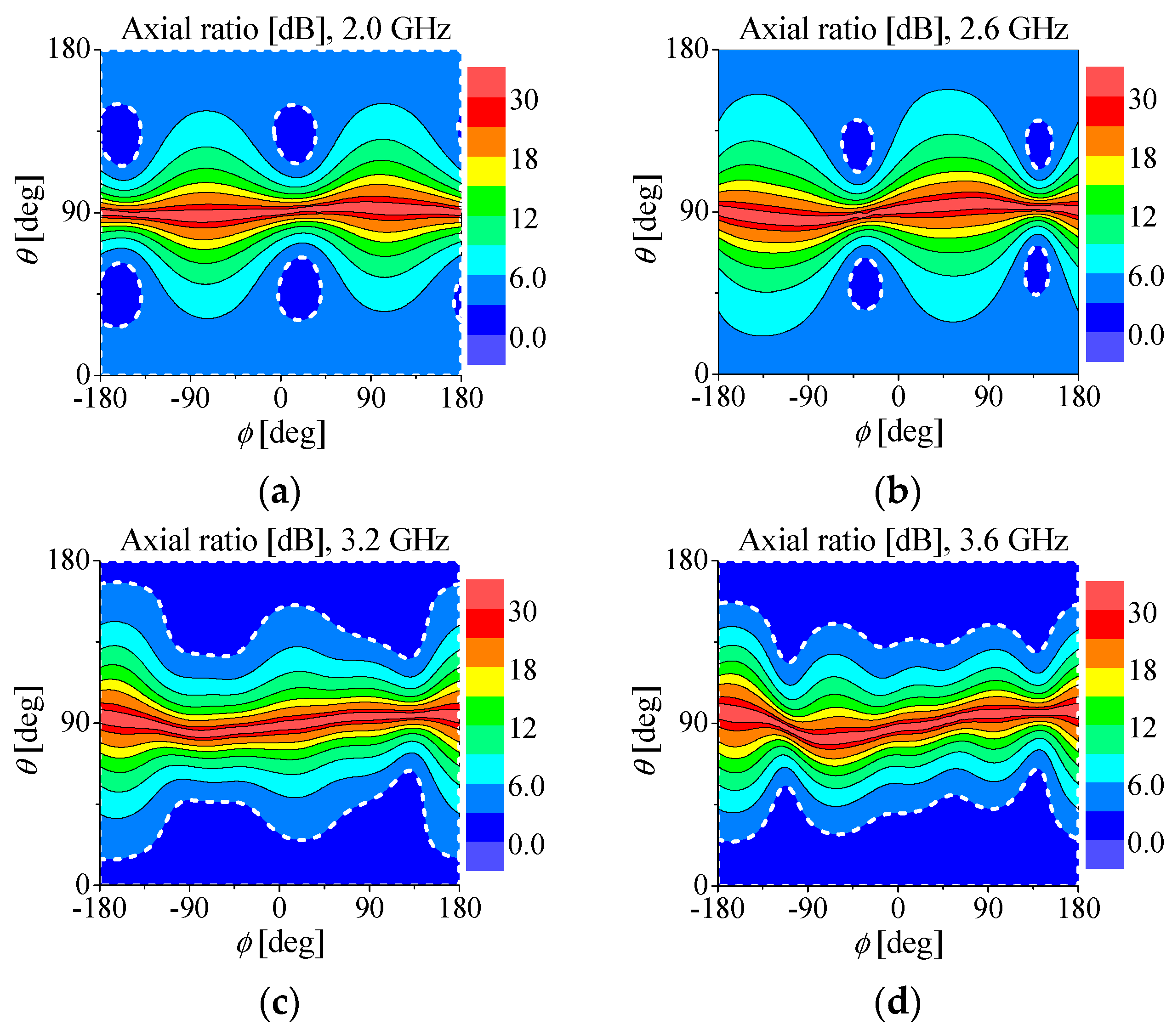
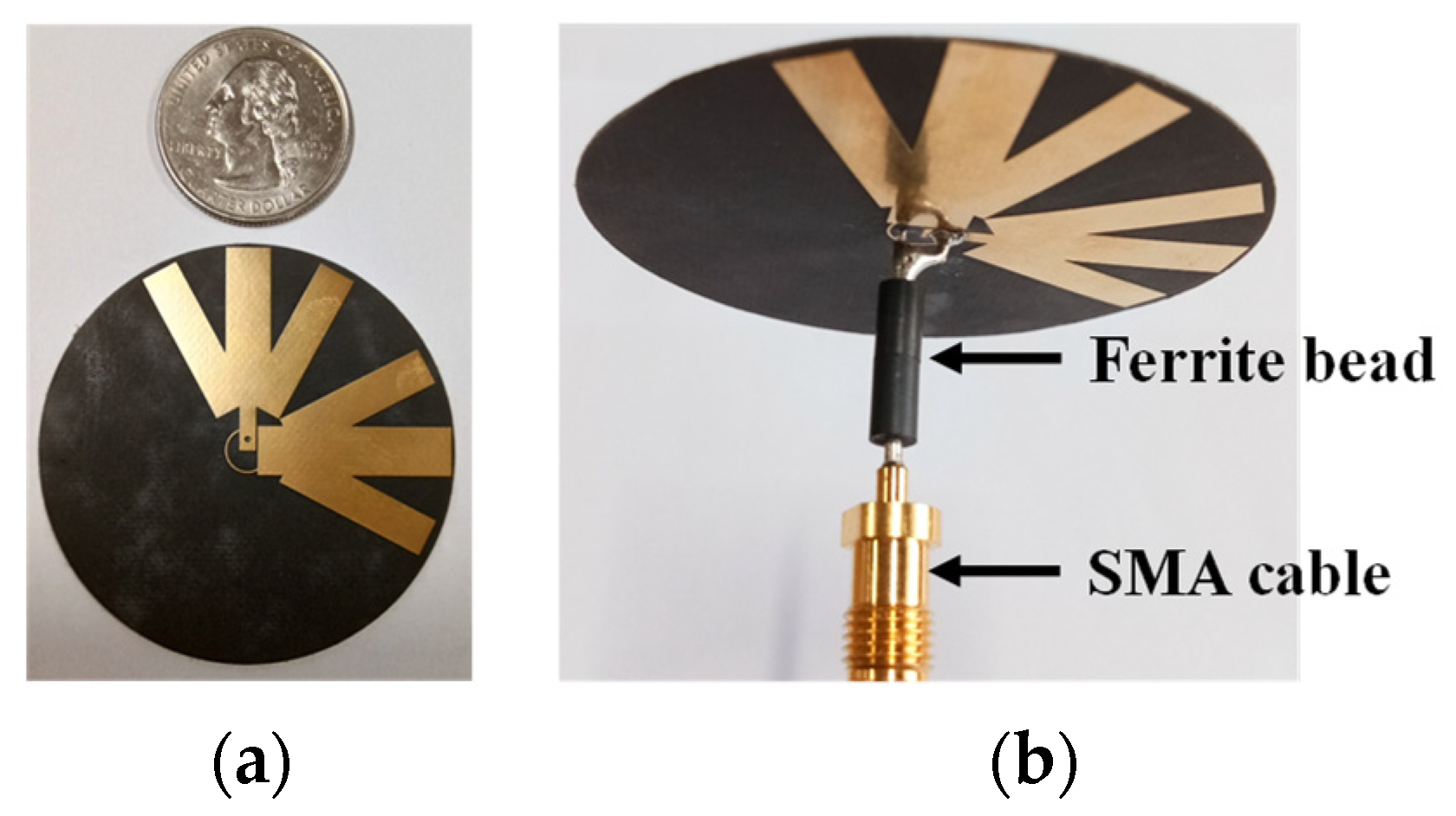

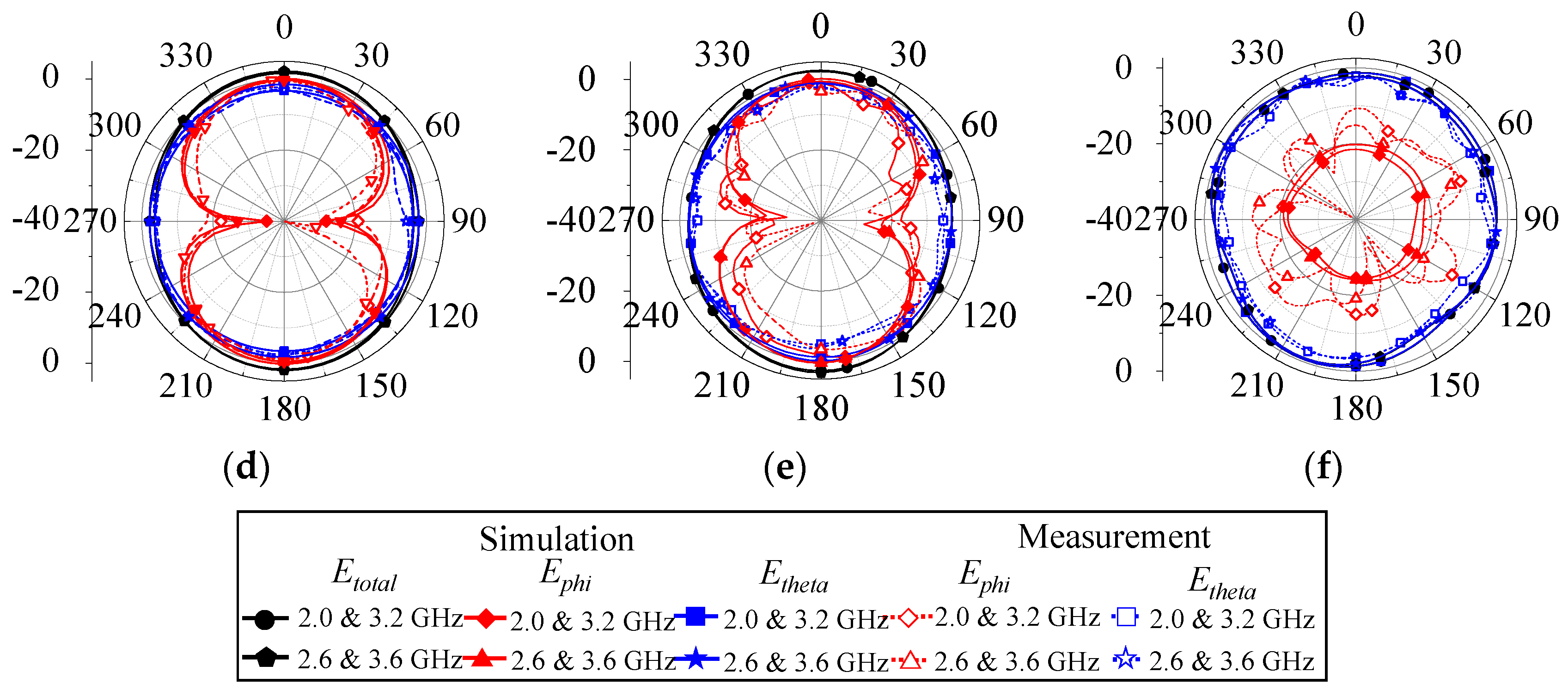
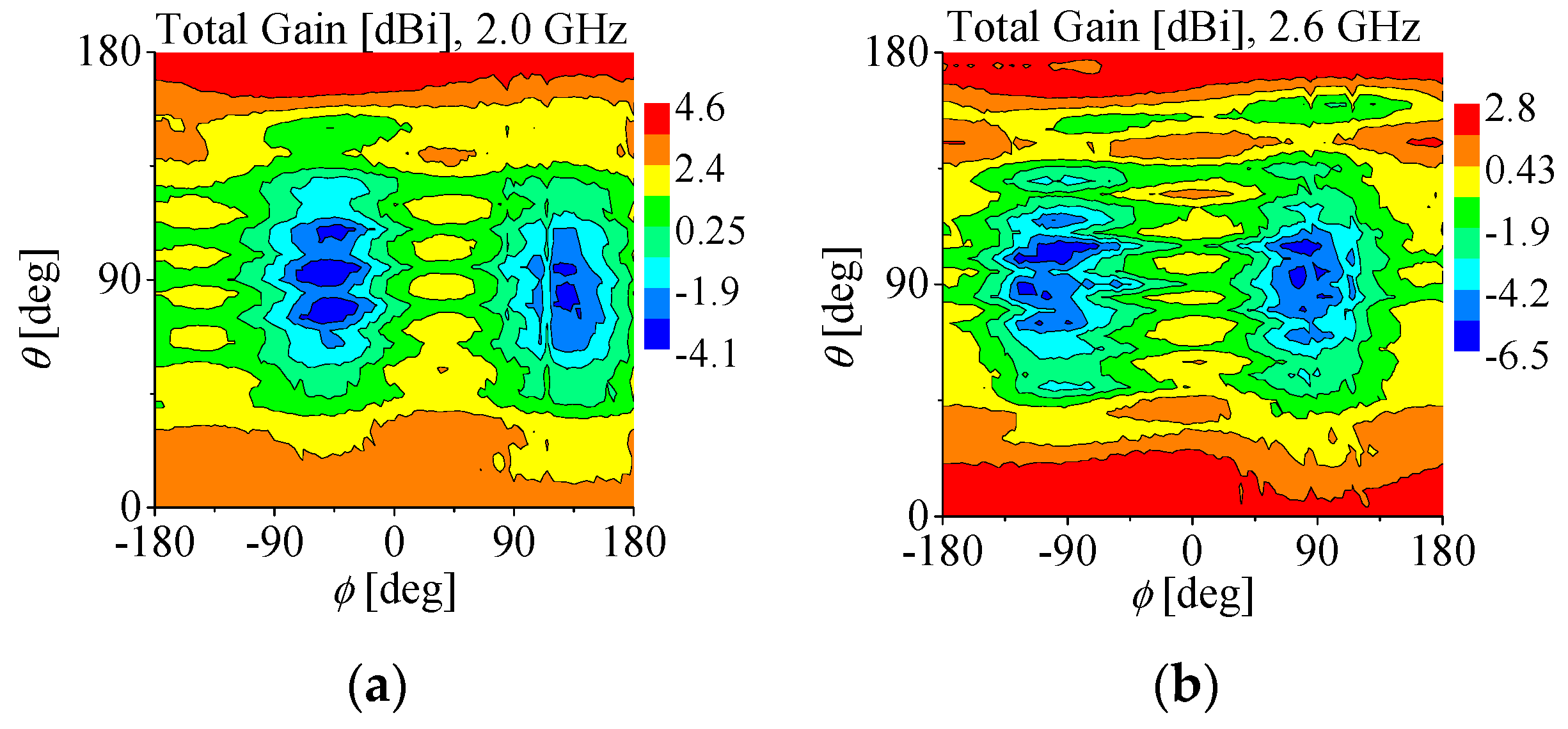
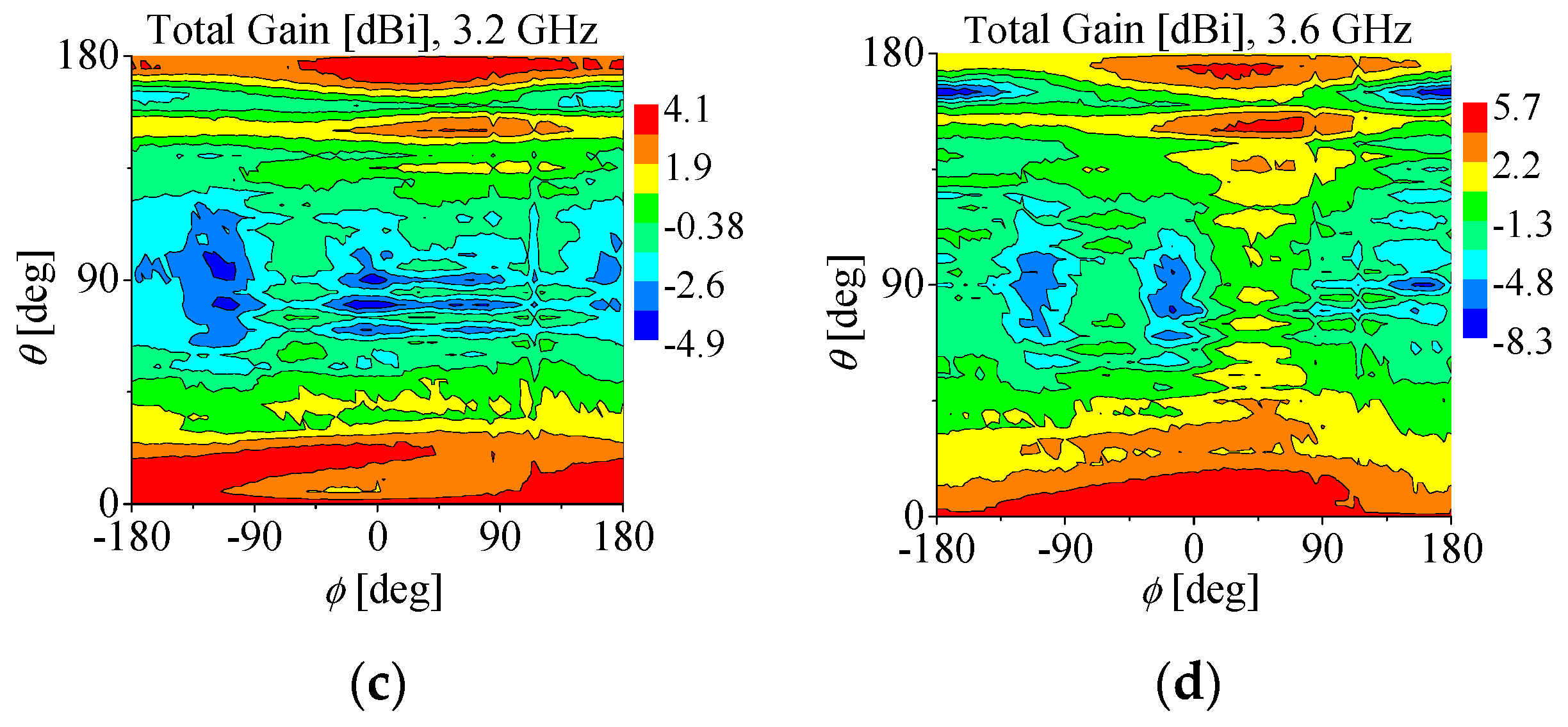

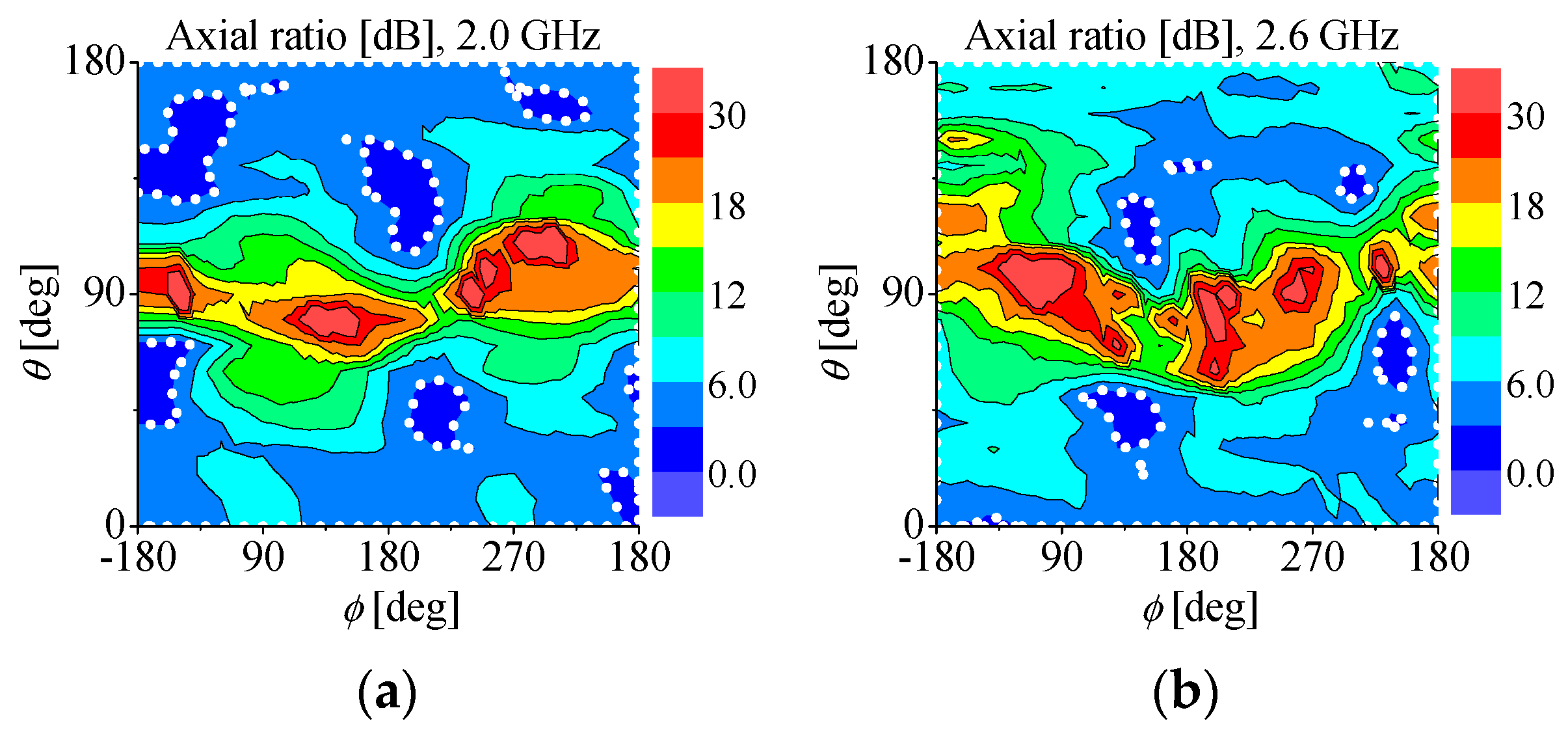




| Parameters | Description | Value |
|---|---|---|
| Lp | Length of the primary dipole | 24.5 |
| Ls | Fork-shaped arm length | 22 |
| W | Width of the dipole | 1.5 |
| α | Angle between the dipoles | 11 |
| wc | Width of the vacant ring | 0.25 |
| rc | Radius of the vacant ring | 2.5 |
| r | Radius of the substrate | 25 |
| h | Thickness of the substrate | 0.254 |
| Ref. | Design Method | Dimension [mm] | ka | Matched Frequency [GHz] | Fractional Bandwidth [%] | Pattern Bandwidth [GHz] | Gain Deviation [dB] | CP | Eff. [%] |
|---|---|---|---|---|---|---|---|---|---|
| [16] | Electric dipole and loop antenna | 25 (Radius) × 2.2 (H) | 0.48 | 0.95 | 2.4 | N/A | 4.5 | No | 81 |
| [23] | Meandered dipole | 98.7 (L) × 14.2 (W) × 0.05 (H) | 0.9 | 0.84–0.95 | 20 | N/A | N/A | No | N/A |
| [24] | Twisted dipole with matching network | 79.2 (L) × 53.1 (W) × 0.05 (H) | 1.6 | 0.84–0.92 | 8.5 | 0.88–0.96 | 6 | No | N/A |
| [25] | L-shaped monopole with feeding network | 45 (L) × 45 (W) × 0.8 (H) | 1.46 | 2.2–2.7 | 20.8 | 2.36–2.53 | 6 | No | 80 |
| [26] | Electric dipole along x, y, and z-axes | 95 (L) × 95 (W) × 95 (H) | 1.2 | 1.31–1.81 | 32 | 1.5 | 12.52 | Yes | N/A |
| [27] | Inverted-F antenna | 52 (L) × 37 (W) × 1.6 (H) | 7.01 | 10.5 | 15 | N/A | 10.5 | No | N/A |
| [30] | Inverted-F antenna | 25 (L) × 25 (W) × 3.1 (H) | 0.88 | 2.4 | 4.1 | N/A | 3.6 | Yes | 65 |
| [42] | Elliptical loop | 100 (L) × 90 (W) × 1.59 (H) | 1.15 | 0.82–3.5 | 124 | N/A | N/A | No | N/A |
| This work | Crossed dipole | 25 (Radius) × 0.254 (H) | 0.94 | 1.8–4.2 | 80 | 1.9–3.3 | 8.4~9.8 | Yes | 90 |
| Frequency [GHz] | Peak Gain [dBi] | |
|---|---|---|
| Omnidirectional antenna | Length of the primary dipole | 24.5 |
| Proposed antenna | 1.8~4.2 | 1.6~4 |
Disclaimer/Publisher’s Note: The statements, opinions and data contained in all publications are solely those of the individual author(s) and contributor(s) and not of MDPI and/or the editor(s). MDPI and/or the editor(s) disclaim responsibility for any injury to people or property resulting from any ideas, methods, instructions or products referred to in the content. |
© 2024 by the authors. Licensee MDPI, Basel, Switzerland. This article is an open access article distributed under the terms and conditions of the Creative Commons Attribution (CC BY) license (https://creativecommons.org/licenses/by/4.0/).
Share and Cite
Radha, S.M.; Lee, M.-S.; Choi, S.H.; Yoon, I.-J. A Compact, Low-Profile, Broadband Quasi-Isotropic Antenna for Non-Line-of-Sight Communications. Appl. Sci. 2024, 14, 2068. https://doi.org/10.3390/app14052068
Radha SM, Lee M-S, Choi SH, Yoon I-J. A Compact, Low-Profile, Broadband Quasi-Isotropic Antenna for Non-Line-of-Sight Communications. Applied Sciences. 2024; 14(5):2068. https://doi.org/10.3390/app14052068
Chicago/Turabian StyleRadha, Sonapreetha Mohan, Mee-Su Lee, Seong Hoon Choi, and Ick-Jae Yoon. 2024. "A Compact, Low-Profile, Broadband Quasi-Isotropic Antenna for Non-Line-of-Sight Communications" Applied Sciences 14, no. 5: 2068. https://doi.org/10.3390/app14052068
APA StyleRadha, S. M., Lee, M.-S., Choi, S. H., & Yoon, I.-J. (2024). A Compact, Low-Profile, Broadband Quasi-Isotropic Antenna for Non-Line-of-Sight Communications. Applied Sciences, 14(5), 2068. https://doi.org/10.3390/app14052068





